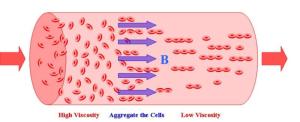摘要:美国研究人员发现,如果人置身于磁场之中,可以减少患心脏病的几率,因为磁场可以让人全身的血流变得更加通畅。虽然现在这项研究仅仅处于原理验证阶段,但研究人员相信他们的技术最终能够发现一种手段,来替代一系列治疗心脏病的药物。
心脏病和中风可能因为各种各样的原因发作。但是调查显示,所有的血管疾病都与一个普遍的症状有关,即高血粘度。医生经常开一些像阿司匹林的药物来帮助患者降低其血粘度,但是这种做法会带来不必要的副作用,这些副作用常常跟胃刺激有关。现在,根据坦普尔大学的陶荣佳(Rongjia Tao)和他密歇根大学的同事黄克(Ke Huang)的研究,一种取代药物的疗法在可能会出现。
在他们的实验中,陶荣佳和黄克展示了将一个1.3特斯拉(磁场强度单位)的磁脉冲加在少量血液样本上的实验,发现这样可以显著降低其粘度。他们把大约8毫升具有7厘泊(粘度单位)粘度(超过健康标准)的血液放在一个温度保持在体温(37℃)的试管中。这个试管是一个毛细管粘度计的组成部分,该粘度计是用来测量液体粘度的。然后,将样品放置在通过缠绕在试管边缘的线圈而产生的磁场中,该磁场的方向与血液流动方向相同。经过一分钟磁场的作用,样品血粘度减少了33%即4.75厘泊。将样品置于磁场之外200分钟,其血粘度仅仅小幅度上升至5.4厘泊,该粘度依旧在健康标准以下。
在物理评论E(Physical Review E)杂志接受出版的一篇论文中,研究者们描述了上述效应是如何由于血液中的红细胞的反应而造成的。这些富铁细胞是血细胞中最常见的类型,它们在给全身运输氧气的过程中起着主导作用。在强磁场的影响下,红细胞会顺着磁场线的方向排列成细胞链,其中会有若干红细胞在领头细胞之后排列成一队。这个过程能够使细胞以一种更通畅的方式通过血液,因而会减小血粘度。
对于临床试验
陶荣佳说,病人们在3特斯拉以下的磁场中都是安全的。他准备将一个跟血管大小相似的毛细管置于磁场里,然后测试其中的血液流动来进一步研究这个问题。而且,他还准备申请美国国家卫生研究所(NIH)的科研补助金来促进实施该项研究的临床试验。
伦敦大学学院的数学家卡尔维斯·扬松斯认为:这些研究者们可能正在经行一项“非常有趣”的研究。他还说:“若是该效应真正存在,那么对于我而言,这将不难将其应用在临床环境之中。”但是,同时他认为在证明该过程的安全性上,依旧有很多工作要做。“例如,这会不会导致血液凝块呢?”他说。
普林斯顿大学的材料科学家贾钦托·斯科尔斯志在推进医疗应用的发展,他认为,在医学领域,存在一种对于这种基于物理的创新的“极大渴望”。“我相信这项工作已经衍生出了很多有趣的问题,而且一个新的研究领域已为我们敞开大门。”他说。
但是在医学领域中,这项新技术的需求和安全依旧需要得到人们的认可。在芝加哥大学开展风湿病研究的的医学博士塔米·尤斯特认为,焦点应该集中在对血管疾病病因的研究上。她说:“治病至关重要,但是找到导致疾病的根本原因才是缓解症状的最佳方法。”
生物探索推荐英文原文:
Using Magnets to Help Prevent Heart Attacks: Magnetic Field Can Reduce Blood Viscosity, Physicist Discovers

Aggregated red-cell clusters have a streamlined shape, leading to further viscosity reduction.
If a person's blood becomes too thick it can damage blood vessels and increase the risk of heart attacks. But a Temple University physicist has discovered that he can thin the human blood by subjecting it to a magnetic field.
Rongjia Tao, professor and chair of physics at Temple University, has pioneered the use of electric or magnetic fields to decrease the viscosity of oil in engines and pipelines. Now, he is using the same magnetic fields to thin human blood in the circulation system.
Because red blood cells contain iron, Tao has been able to reduce a person's blood viscosity by 20-30 percent by subjecting it to a magnetic field of 1.3 Telsa (about the same as an MRI) for about one minute.
Tao and his collaborator tested numerous blood samples in a Temple lab and found that the magnetic field polarizes the red blood cells causing them to link together in short chains, streamlining the movement of the blood. Because these chains are larger than the single blood cells, they flow down the center, reducing the friction against the walls of the blood vessels. The combined effects reduce the viscosity of the blood, helping it to flow more freely.
When the magnetic field was taken away, the blood's original viscosity state slowly returned, but over a period of several hours.
"By selecting a suitable magnetic field strength and pulse duration, we will be able to control the size of the aggregated red-cell chains, hence to control the blood's viscosity," said Tao. "This method of magneto-rheology provides an effective way to control the blood viscosity within a selected range."
Currently, the only method for thinning blood is through drugs such as aspirin; however, these drugs often produce unwanted side effects. Tao said that the magnetic field method is not only safer, it is repeatable. The magnetic fields may be reapplied and the viscosity reduced again. He also added that the viscosity reduction does not affect the red blood cells' normal function.
Tao said that further studies are needed and that he hopes to ultimately develop this technology into an acceptable therapy to prevent heart disease.
Tao and his former graduate student, Ke "Colin" Huang, now a medical physics resident in the Department of Radiation Oncology at the University of Michigan, are publishing their findings in the journal Physical Review E.







